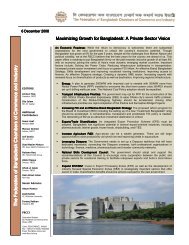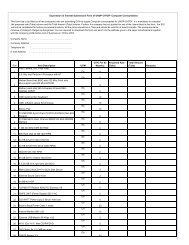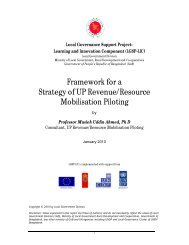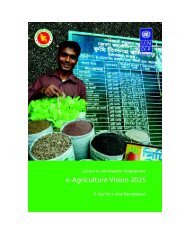The probable impacts of climate change on poverty - UNDP
The probable impacts of climate change on poverty - UNDP
The probable impacts of climate change on poverty - UNDP
You also want an ePaper? Increase the reach of your titles
YUMPU automatically turns print PDFs into web optimized ePapers that Google loves.
4.1 Climate Change - Global C<strong>on</strong>text<br />
<str<strong>on</strong>g>The</str<strong>on</strong>g> Fourth Assessment Report (AR4) <str<strong>on</strong>g>of</str<strong>on</strong>g> the Intergovernmental Panel <strong>on</strong> Climate Change had unequivocally<br />
c<strong>on</strong>firmed the warming <str<strong>on</strong>g>of</str<strong>on</strong>g> <str<strong>on</strong>g>climate</str<strong>on</strong>g> system and linked it directly to human activity. <str<strong>on</strong>g>The</str<strong>on</strong>g> effects <str<strong>on</strong>g>of</str<strong>on</strong>g> warming were<br />
already grave and they were growing. <str<strong>on</strong>g>The</str<strong>on</strong>g> global average surface temperature has already increased by 0.74oC during last 100 years; sea level rose at an average rate <str<strong>on</strong>g>of</str<strong>on</strong>g> 1.8 mm per year over 1961 to 2003; mountain glaciers<br />
and snow cover have declined <strong>on</strong> average in both hemispheres; eleven <str<strong>on</strong>g>of</str<strong>on</strong>g> the last twelve years (1995-2006) rank<br />
am<strong>on</strong>g the 12 warmest years. C<strong>on</strong>tinued greenhouse gas emissi<strong>on</strong>s at or above current rates would cause<br />
further warming and induce many <str<strong>on</strong>g>change</str<strong>on</strong>g>s in the global climatic system during the 21st century that would very<br />
likely be larger than those observed during the 20th century.<br />
<str<strong>on</strong>g>The</str<strong>on</strong>g> AR4 stated that for the next two decades, a warming <str<strong>on</strong>g>of</str<strong>on</strong>g> about 0.2˚C per decade is projected for a range <str<strong>on</strong>g>of</str<strong>on</strong>g><br />
Special Report <strong>on</strong> Emissi<strong>on</strong> Scenarios (SRES). Even if the c<strong>on</strong>centrati<strong>on</strong>s <str<strong>on</strong>g>of</str<strong>on</strong>g> all greenhouse gases and aerosols had<br />
been kept c<strong>on</strong>stant at year 2000 levels, a further warming <str<strong>on</strong>g>of</str<strong>on</strong>g> about 0.1˚C per decade would be expected.<br />
Expected <str<strong>on</strong>g>change</str<strong>on</strong>g>s in global mean temperature is likely to increase by 1.1 to 6.4˚C from 1990 to 2100 while water<br />
availability will increase in moist tropics and high latitudes and decrease in mid-latitudes and semi-arid low<br />
latitudes. Sea levels are likely to rise in the range <str<strong>on</strong>g>of</str<strong>on</strong>g> 22-34 cm between 1990 and the 2080s. Future tropical<br />
cycl<strong>on</strong>es, typho<strong>on</strong>s, and hurricanes will become more intense, with larger peak wind speeds and heavy<br />
precipitati<strong>on</strong>.<br />
4.1.1 Impacted Sectors: Freshwater Resources<br />
<str<strong>on</strong>g>The</str<strong>on</strong>g> Fourth Assessment Report <str<strong>on</strong>g>of</str<strong>on</strong>g> the IPCC projected that by mid-century, annual average river run<str<strong>on</strong>g>of</str<strong>on</strong>g>f and water<br />
availability are projected to increase by 10-40% at high latitudes and in some wet tropical areas, and decrease by<br />
10-30% over some dry regi<strong>on</strong>s at mid-latitudes and in the dry tropics, some <str<strong>on</strong>g>of</str<strong>on</strong>g> which are presently water-stressed<br />
areas. Drought-affected areas are likely to increase to a c<strong>on</strong>siderable extent. Heavy precipitati<strong>on</strong> events, which<br />
are very likely to increase in frequency, will augment flood risk. In the course <str<strong>on</strong>g>of</str<strong>on</strong>g> this century, water supplies stored<br />
in glaciers and snow cover are projected to decline, reducing water availability in regi<strong>on</strong>s supplied by melt water<br />
from major mountain ranges, where more than <strong>on</strong>e-sixth <str<strong>on</strong>g>of</str<strong>on</strong>g> the world populati<strong>on</strong> currently lives.<br />
4.1.2 Ecosystem<br />
<str<strong>on</strong>g>The</str<strong>on</strong>g> resilience <str<strong>on</strong>g>of</str<strong>on</strong>g> many ecosystems is likely to be exceeded by this century by an unprecedented combinati<strong>on</strong> <str<strong>on</strong>g>of</str<strong>on</strong>g><br />
<str<strong>on</strong>g>climate</str<strong>on</strong>g> <str<strong>on</strong>g>change</str<strong>on</strong>g>, associated with disturbances (e.g., flooding, drought, wildfire, insects, ocean acidificati<strong>on</strong>), and<br />
other global <str<strong>on</strong>g>change</str<strong>on</strong>g> drivers (e.g., land use <str<strong>on</strong>g>change</str<strong>on</strong>g>, polluti<strong>on</strong>, over-exploitati<strong>on</strong> <str<strong>on</strong>g>of</str<strong>on</strong>g> resources). Approximately 20-<br />
30% <str<strong>on</strong>g>of</str<strong>on</strong>g> plant and animal species assessed so far are likely to be at increased risk <str<strong>on</strong>g>of</str<strong>on</strong>g> extincti<strong>on</strong> if increases in<br />
global average temperature exceed 1.5-2.5˚C. For increases in global average temperature exceeding 1.5-2.5˚C<br />
and in c<strong>on</strong>comitant atmospheric carb<strong>on</strong> dioxide c<strong>on</strong>centrati<strong>on</strong>s, there are projected to be major <str<strong>on</strong>g>change</str<strong>on</strong>g>s in the<br />
ecosystem structure and functi<strong>on</strong>, species’ ecological interacti<strong>on</strong>s, and species’ geographical ranges, with<br />
predominantly negative c<strong>on</strong>sequences for biodiversity, and ecosystem goods and services e.g., water and food<br />
supply. <str<strong>on</strong>g>The</str<strong>on</strong>g> progressive acidificati<strong>on</strong> <str<strong>on</strong>g>of</str<strong>on</strong>g> oceans due to increasing atmospheric carb<strong>on</strong> dioxide is expected to have<br />
negative <str<strong>on</strong>g>impacts</str<strong>on</strong>g> <strong>on</strong> marine shell-forming organisms (e.g., corals) and their dependent species.<br />
4.1.3 Food, Fibre & Forest Product<br />
Crop productivity is projected to increase slightly at mid- to high latitudes for local mean temperature increases<br />
<str<strong>on</strong>g>of</str<strong>on</strong>g> up to 1-3˚C depending <strong>on</strong> the crop, and then decrease bey<strong>on</strong>d that in some regi<strong>on</strong>s. At lower latitudes,<br />
especially seas<strong>on</strong>ally dry and tropical regi<strong>on</strong>s, crop productivity is projected to decrease for even small local<br />
temperature increases (1-2˚C), which would increase the risk <str<strong>on</strong>g>of</str<strong>on</strong>g> hunger. Globally, the potential for food<br />
producti<strong>on</strong> is projected to increase with increases in local average temperature over a range <str<strong>on</strong>g>of</str<strong>on</strong>g> 1-3˚C, but above<br />
this it is projected to decrease. Increase in the frequency <str<strong>on</strong>g>of</str<strong>on</strong>g> droughts and floods is projected to affect local crop<br />
producti<strong>on</strong> negatively, especially in subsistence sectors at low latitudes.<br />
Globally, the potential for food producti<strong>on</strong> is projected to increase with increases in local average temperature<br />
over a range <str<strong>on</strong>g>of</str<strong>on</strong>g> 1-3˚C, but above this it is projected to decrease. Regi<strong>on</strong>al <str<strong>on</strong>g>change</str<strong>on</strong>g>s in the distributi<strong>on</strong> and<br />
<str<strong>on</strong>g>The</str<strong>on</strong>g> Probable Impacts <str<strong>on</strong>g>of</str<strong>on</strong>g> Climate Change <strong>on</strong> Poverty and Ec<strong>on</strong>omic Growth and<br />
the Opti<strong>on</strong>s <str<strong>on</strong>g>of</str<strong>on</strong>g> Coping with adverse Effect <str<strong>on</strong>g>of</str<strong>on</strong>g> Climate Change in Bangladesh<br />
19










